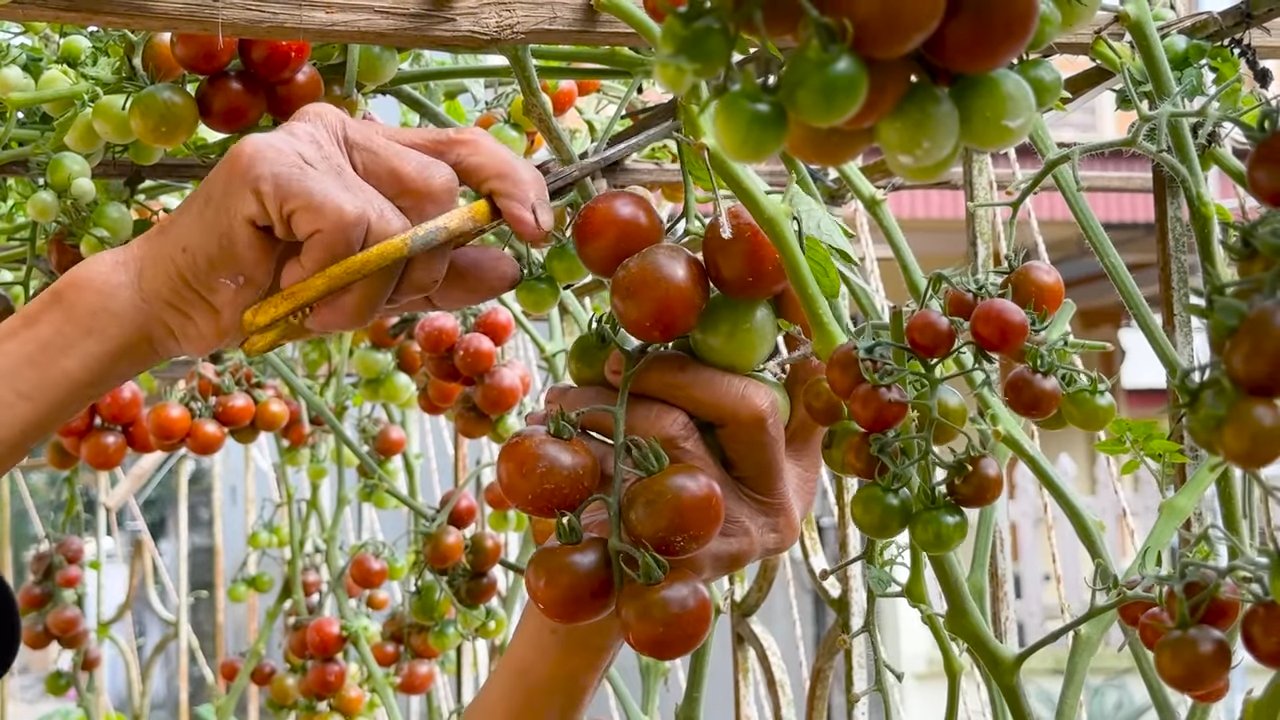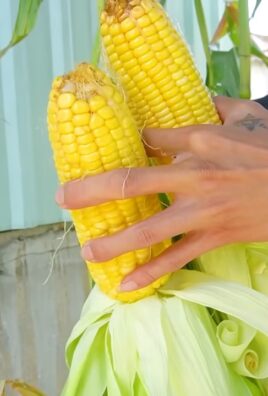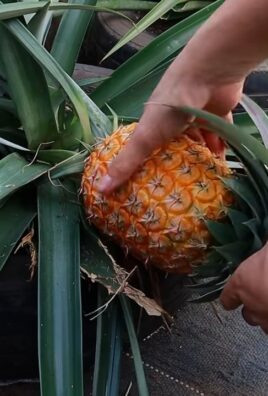Growing Grape Tomatoes for Beginners can seem daunting, but trust me, it’s one of the most rewarding experiences a home gardener can have! Imagine popping sweet, juicy grape tomatoes straight from your own backyard into your salad or snacking on them right off the vine. Sounds idyllic, right? Well, it’s totally achievable, even if you’re a complete newbie.
The humble tomato, originating in South America, has a rich history, evolving from a wild berry to the culinary staple we know and love. While large beefsteak tomatoes often steal the spotlight, grape tomatoes, with their concentrated flavor and bite-sized appeal, have carved out their own special place in our hearts (and gardens!).
But why should you bother with growing grape tomatoes for beginners? Well, for starters, they’re incredibly prolific! One plant can yield a surprising amount of fruit, providing you with a steady supply throughout the growing season. Plus, they’re relatively low-maintenance compared to some other tomato varieties, making them perfect for busy gardeners or those just starting out. I’m going to share some simple DIY tricks and hacks that will help you succeed, even if you don’t have a green thumb. Get ready to enjoy the satisfaction of harvesting your own delicious, homegrown grape tomatoes!

Growing Grape Tomatoes: Your DIY Guide for Beginners
Hey, you! Do you also want to bring summer to your balcony or garden? Then let’s grow grape tomatoes together! It’s easier than you think, and the result – sweet, juicy tomatoes straight from the plant – is simply unbeatable. I’ll show you how it’s done!
What You Need: Your Shopping List
Before we start, we need a few things. Don’t worry, most of them are easy to get:
- Grape tomato seeds or young plants: Seeds are cheaper, but young plants save you time. I recommend starting with young plants if you’re impatient.
- Seed starting mix (optional, for seeds): Special soil for starting seeds is lower in nutrients and promotes root growth.
- Pots or containers: Make sure they are large enough (at least 10 liters in volume per plant) and have drainage holes.
- Tomato soil: Good quality is important! It should be loose, rich in humus, and well-draining.
- Stakes or trellises: Grape tomatoes grow tall and need support.
- Watering can or garden hose: For watering, of course!
- Liquid fertilizer for tomatoes: For a bountiful harvest.
- Pruning shears: For pruning and harvesting.
- (Optional) Mulch material: Straw, wood chips, or grass clippings help to retain moisture in the soil and suppress weeds.
Phase 1: Starting from Seed (If You’re Starting with Seeds)
If you’ve decided on seeds, your tomato adventure begins a little earlier. Don’t panic, it’s not difficult!
- Sowing: Fill small seed pots or a seed tray with seed starting mix. Lightly moisten the soil. Place 2-3 seeds per pot about 0.5 cm deep into the soil. Cover them lightly with soil and press down gently.
- Location: Place the pots in a warm, bright place. A windowsill above a heater is ideal. The ideal germination temperature is 20-25°C.
- Moisture: Keep the soil moist, but not wet. It’s best to spray it regularly with a spray bottle.
- Germination: After about 7-14 days, the first seedlings should appear.
- Pricking out: As soon as the seedlings have their first true leaves (besides the initial seed leaves), it’s time to prick them out. This means you carefully transplant the small plants into larger pots so they have more room to grow. Fill the new pots with tomato soil. Carefully lift the seedlings out of the seed tray with a dibber or a spoon and place them in the new pots. Be careful not to damage the roots. Water the seedlings well after pricking them out.
Phase 2: Transplanting Outdoors or into a Container
Whether you started with seeds or bought young plants, the time will come to plant the tomatoes outdoors or in their final container.
- The right time: Wait until there is no more danger of frost. This is usually in mid-May. Tomatoes are very sensitive to cold.
- Preparing the pots/bed: Fill the pots or the garden bed with tomato soil. Make sure the soil is loose and well-draining. If you are planting in a bed, loosen the soil well beforehand and remove weeds.
- Planting: Dig a hole that is slightly larger than the root ball of the tomato plant. Carefully place the plant in it and fill the hole with soil. Press the soil down lightly. You can plant the tomato plant a little deeper than it was in its previous pot. This encourages root formation.
- Planting distance: Ensure sufficient spacing between plants. Grape tomatoes need room to grow. Plan for about 50-60 cm between plants.
- Adding support: Place a stake next to the tomato plant or install a trellis. The plant will be tied to it over time.
- Watering in: Water the tomato plants well after planting.
Phase 3: Care and Nurturing – How to Keep Your Tomatoes Happy
Now the real work begins: caring for your tomato plants. But don’t worry, with a few simple tricks, you can ensure they thrive.
- Watering: Tomatoes need regular water, especially on hot days. It’s best to water in the morning or evening when the sun isn’t as strong. Avoid watering the leaves, as this can promote fungal diseases. Instead, water directly at the roots. The soil should always be slightly moist, but not wet.
- Fertilizing: Tomatoes are heavy feeders and need a lot of nutrients. Fertilize them regularly with a liquid tomato fertilizer. Start about 2-3 weeks after planting and then fertilize every 1-2 weeks. Follow the instructions on the fertilizer package.
- Pinching out (Pruning): Removing suckers is important for a large harvest. This involves removing the side shoots that grow in the leaf axils. These shoots take unnecessary strength and energy from the plant, which it can better use for fruit production. It’s best to break off the side shoots early with your fingers.
- Supporting: Regularly tie the tomato plant to the stake or trellis to prevent it from breaking.
- Protection from diseases and pests: Tomatoes are susceptible to various diseases and pests. Look for signs like yellow leaves, spots, or aphid infestations. If necessary, you can use organic pesticides. Good air circulation around the plants helps prevent fungal diseases.
- Mulching: A layer of mulch around the tomato plants helps to retain moisture in the soil, suppress weeds, and protect the soil from drying out. Use straw, wood chips, or grass clippings for this.
Phase 4: The Harvest – The Reward for Your Effort
Finally, the time has come: the first grape tomatoes are ripe!
- The right time: Grape tomatoes are ripe when they have an intense red color and are easily detached from the stem.
- Harvesting: Carefully pick the ripe tomatoes. It’s best to use pruning shears so you don’t damage the stem.
- Storage: Grape tomatoes are best kept at room temperature. They quickly lose their flavor in the refrigerator.
Additional Tips for a Bountiful Harvest
Patience: Tomatoes need time to grow and ripen. Be patient and don’t get discouraged if it doesn’t work out right away.
Sunshine: Tomatoes love the sun! Place them in a sunny location where they get at least 6 hours of sun per day.
Ventilation: Ensure good air circulation around the plants to prevent fungal diseases.
Regular checks: Check your tomato plants regularly for diseases and pests. The sooner you identify problems, the better you can combat them.
Variety selection: There are many different varieties of grape tomatoes. Try different ones to find your favorite.

Conclusion
So, there you have it! Mastering the art of growing grape tomatoes, even for beginners, is entirely within your reach. This isn’t just about saving a few dollars at the grocery store; it’s about experiencing the profound satisfaction of nurturing life from a tiny seed to a bountiful harvest. Imagine the burst of sweet, tangy flavor from a grape tomato you grew yourself – a flavor far superior to anything you can buy.
This DIY approach to growing grape tomatoes offers a multitude of benefits. You control the entire process, ensuring your tomatoes are free from harmful pesticides and grown with the utmost care. You can select heirloom varieties with unique flavors and colors, expanding your culinary horizons beyond the standard supermarket offerings. Plus, gardening is a fantastic stress reliever and a great way to connect with nature.
But the best part? It’s incredibly rewarding. Watching your seedlings sprout, tending to their growth, and finally harvesting those juicy, sun-ripened grape tomatoes is an experience that will leave you feeling accomplished and connected to the earth.
Don’t be afraid to experiment! Try different soil mixes, fertilizer combinations, or even companion planting techniques to see what works best for your specific environment. Consider growing your grape tomatoes in containers if you have limited space, or try different varieties like ‘Sungold’ for an exceptionally sweet flavor or ‘Black Pearl’ for a stunning visual appeal. You can even explore vertical gardening techniques to maximize your yield in a small area.
We’ve provided a solid foundation for success, but the real magic happens when you personalize the process and discover what works best for you. Remember to be patient, observant, and willing to learn from your mistakes. Gardening is a journey, not a destination.
Now, it’s your turn! Grab some seeds, prepare your soil, and embark on this exciting adventure of growing grape tomatoes. We’re confident that you’ll be amazed by the results. And most importantly, don’t forget to share your experiences with us! Tell us about your successes, your challenges, and any tips or tricks you discover along the way. Let’s build a community of grape tomato enthusiasts, sharing our knowledge and inspiring each other to grow the best tomatoes possible. Happy gardening!
Frequently Asked Questions (FAQ)
What are the best grape tomato varieties for beginners?
Choosing the right variety is crucial for success, especially when you’re just starting out. Some excellent choices for beginners include ‘Sungold’, ‘Sweet Million’, and ‘Juliet’. ‘Sungold’ is known for its exceptional sweetness and early ripening. ‘Sweet Million’ is a prolific producer, yielding hundreds of small, sweet tomatoes per plant. ‘Juliet’ is a hybrid variety that is disease-resistant and produces elongated, plum-shaped grape tomatoes with a slightly tangy flavor. These varieties are generally easy to grow and relatively resistant to common tomato diseases, making them ideal for novice gardeners. Consider your local climate and growing conditions when making your selection. Local nurseries can provide valuable insights into which varieties thrive in your area.
How often should I water my grape tomato plants?
Watering frequency depends on several factors, including the weather, soil type, and the size of your plants. As a general rule, water deeply and less frequently, rather than shallowly and often. This encourages deep root growth, which makes the plants more resilient to drought. Check the soil moisture by sticking your finger about an inch into the soil. If it feels dry, it’s time to water. During hot, dry weather, you may need to water daily, while during cooler, wetter periods, you may only need to water every few days. Avoid overwatering, as this can lead to root rot and other problems. Using a soaker hose or drip irrigation system can help deliver water directly to the roots, minimizing water waste and reducing the risk of foliar diseases.
What kind of fertilizer should I use for grape tomatoes?
Grape tomatoes benefit from regular fertilization, especially during the growing season. A balanced fertilizer with an NPK ratio (nitrogen, phosphorus, potassium) of 10-10-10 or 14-14-14 is a good starting point. However, as the plants begin to flower and produce fruit, they will need more phosphorus and potassium. Consider switching to a fertilizer with a higher phosphorus and potassium content, such as 5-10-10 or 5-15-15. Organic options like compost tea, fish emulsion, and bone meal are also excellent choices. Apply fertilizer according to the package directions, being careful not to over-fertilize, as this can damage the plants. Side-dressing with compost or well-rotted manure can also provide a slow-release source of nutrients.
How do I prevent common tomato diseases?
Preventing diseases is key to a successful grape tomato harvest. Choose disease-resistant varieties whenever possible. Practice good sanitation by removing any fallen leaves or debris from around the plants. Water at the base of the plants to avoid wetting the foliage, which can create a favorable environment for fungal diseases. Provide good air circulation by spacing the plants properly and pruning any overcrowded foliage. Consider using a copper fungicide or other organic disease control products as a preventative measure. Monitor your plants regularly for signs of disease, such as spots on the leaves or wilting. If you spot any problems, take action immediately to prevent the disease from spreading. Crop rotation can also help prevent soilborne diseases from building up in your garden.
How do I deal with pests on my grape tomato plants?
Pests can be a nuisance, but there are many ways to control them without resorting to harsh chemicals. Regularly inspect your plants for signs of pests, such as aphids, whiteflies, or tomato hornworms. Hand-picking pests off the plants is often effective for small infestations. Introduce beneficial insects, such as ladybugs and lacewings, to your garden to help control pest populations. Insecticidal soap and neem oil are effective organic treatments for many common tomato pests. Use row covers to protect your plants from pests early in the season. Companion planting with herbs like basil and marigolds can also help deter pests.
When is the best time to harvest grape tomatoes?
Grape tomatoes are typically ready to harvest about 60-80 days after transplanting. The best time to harvest is when the tomatoes are fully colored and slightly soft to the touch. They should easily detach from the vine with a gentle tug. Avoid harvesting tomatoes that are still green or hard, as they will not ripen properly off the vine. Harvest regularly to encourage continued production. Overripe tomatoes can attract pests and diseases, so it’s important to stay on top of harvesting.
Can I grow grape tomatoes in containers?
Yes, grape tomatoes are well-suited for container gardening. Choose a large container, at least 12 inches in diameter, with good drainage. Use a high-quality potting mix and provide regular watering and fertilization. Container-grown tomatoes may need to be watered more frequently than those grown in the ground, especially during hot weather. Choose a sunny location that receives at least 6-8 hours of sunlight per day. Consider using a tomato cage or stake to support the plants as they grow.
What do I do with all the grape tomatoes I’ve harvested?
The possibilities are endless! Enjoy them fresh in salads, snacks, or as a topping for pizzas and pasta dishes. Roast them with herbs and garlic for a delicious side dish. Make a batch of homemade tomato sauce or salsa. Pickle them for a tangy treat. You can also freeze or dry grape tomatoes for later use. Grape tomatoes are a versatile and delicious addition to any meal.




Leave a Comment